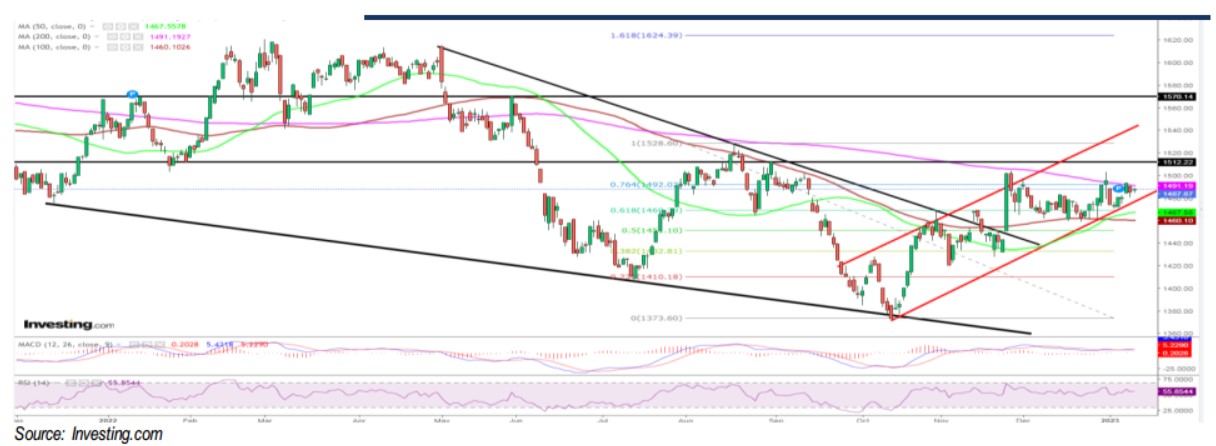Technical Tracker - Looking for the Silver Lining
HLInvest
Publish date: Thu, 12 Jan 2023, 09:18 AM

KLCI recorded back-to-back losses in 2022. After hitting a high of 1,497.2 (1 Dec), KLCI slid to a low of 1,459.3 following (1) Powell’s hawkish speech post Dec FOMC meeting, (2) IMF’s stern warning of global recession in 2023, (3) China’s Covid -zero policy U-turn which injected uncertainty into already fragile growth outlook amid an exponential surge of Covid cases, (4) potential end of its ultra -easy monetary policy after the BOJ’s surprise change to yield curve parameter and (5) persistent foreign net outflows (Jan: +RM73m, Sep-Dec: -RM3.9bn).
However, expectations of a potential Fed "pivot" in 2H23 (as inflation falls and the unemployment rate rises), optimism that China's decisive reopening may lead to a robust economic recovery for China and global growth in 1H23, abated domestic political risks (following a confidence vote in Parliament and ruling parties signing a coalition pact to ensure greater stability), and mild window dressing lifted the benchmark to close 2022 at 1,495 pts. Despite gaining 0.4% in Dec and 7.2% in 4Q22, KLCI still tumbled 3.1% in 2022 (2021: -5.1%).
Hopeful for a positive start in Jan. Overall, we expect 2023 to be a less stormy year for the local bourse (but certainly not a smooth journey), following a cumulative 2 -year loss of 8.2%. HLIB is projecting a 2023 KLCI target of 1,580, premised on 15.1x PE (- 1SD to 5Y mean) tagged to CY23 EPS. Technically, we envision KLCI to chalk up a positive month in Jan (-0.5% so far), barring a decisive breakdown below the key 1,454-1,468 supports (resistance: 1,512-1,528-1,540). Moreover, CY2023’s valuation is not especially demanding as KLCI is now trading at 12.5x P/E (-3SD vs 10Y mean) and supported by low foreign shareholding (Dec 2022: 20.6% vs historical low of 20.1% in Aug 2022), which would help contain an exodus. Major events to watch out for in Jan include (1) the FOMC meeting (31 Jan-1 Feb) and the BNM OPR decision (19 Jan) to assess the 2022 cumulative impact of 4.25% Fed rate and 1% OPR hikes, (2) the UMNO general assembly (11-14 Jan), (3) the start of the US 4Q22 results season (starting this Friday from US major banks), (4) political turmoil in Sabah, and (5) opportunities and risks for the global economy and markets following China’s borders’ reopening on 8 Jan.
Investing in high-quality stock. We advocate a risk-on strategy, capitalising on the relief rally that began from 1,373 (2Y low) and continued into January. While none of us can predict how an environment of continued market volatility (predominantly dominated by headlines from elevated inflation, a hawkish Fed, China’s reopening, and recessionary fears) will ultimately play out, we believe investing in high -quality companies with strong business models, sound balance sheets, and stable dividends could form the bedrock of an investor’s equity portfolio, reduce volatility, and help weather the potential market storm.
Appealing investment themes include: (1) winners of China’s reopening; (2) beneficiaries of rate hikes; (3) Alpha picks and (4) high dividend yielders. Our January picks are BIMB (a laggard trading at depressed valuations with bright structural long term growth prospects), ANCOMNY (the sole producer of agrichemicals' active ingredients (AIs) in Southeast Asia and a key player in Asia), FLBHD (solid balanc e sheet and sound DY to cushion downside), SUNWAY (benefiting from domestic economy recovery and border re-opening), OSK (an alpha pick, deep in value and yet to be re-rated).
Source: Hong Leong Investment Bank Research - 12 Jan 2023


















